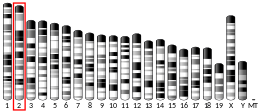리아노딘수용체3 Ryanodine receptor 3
리아노딘 수용체 3은 리아노딘 수용체의 한 종류이며, RYR3 [5] 단백질 이다.이 유전자에 의해 코드된 단백질 은 칼슘 채널 이자 식물 알칼로이드 리아노딘 의 수용체 이다. RYR3와 RYR1 은 골격근 의 [6] 칼슘 이온 농도를 조절한다.
「 」를 참조해 주세요. 레퍼런스 ^ a b c GRCh38: 앙상블 릴리즈 89: ENSG00000198838 - 앙상블 , 2017년 5월^ a b c GRCm38: 앙상블 릴리즈 89: ENSMUSG000057378 - 앙상블 , 2017년 5월^ "Human PubMed Reference:" . National Center for Biotechnology Information, U.S. National Library of Medicine .^ "Mouse PubMed Reference:" . National Center for Biotechnology Information, U.S. National Library of Medicine .^ Sorrentino V, Giannini G, Malzac P, Mattei MG (Feb 1994). "Localization of a novel ryanodine receptor gene (RYR3) to human chromosome 15q14-q15 by in situ hybridization". Genomics . 18 (1): 163–5. doi :10.1006/geno.1993.1446 . PMID 8276408 . ^ Perez CF, López JR, Allen PD (March 2005). "Expression levels of RyR1 and RyR3 control resting free Ca2+ in skeletal muscle". Am. J. Physiol., Cell Physiol . 288 (3): C640–9. doi :10.1152/ajpcell.00407.2004 . PMID 15548569 .
추가 정보 Bertocchini F, Ovitt CE, Conti A, et al. (1997). "Requirement for the ryanodine receptor type 3 for efficient contraction in neonatal skeletal muscles" . EMBO J . 16 (23): 6956–63. doi :10.1093/emboj/16.23.6956 . PMC 1170299 PMID 9384575 . Bultynck G, De Smet P, Rossi D, et al. (2001). "Characterization and mapping of the 12 kDa FK506-binding protein (FKBP12)-binding site on different isoforms of the ryanodine receptor and of the inositol 1,4,5-trisphosphate receptor" . Biochem. J . 354 (Pt 2): 413–22. doi :10.1042/bj3540413 . PMC 1221670 PMID 11171121 . Schwarzmann N, Kunerth S, Weber K, et al. (2002). "Knock-down of the type 3 ryanodine receptor impairs sustained Ca2+ signaling via the T cell receptor/CD3 complex" . J. Biol. Chem . 277 (52): 50636–42. doi :10.1074/jbc.M209061200 PMID 12354756 . Nakashima Y, Nishimura S, Maeda A, et al. (1997). "Molecular cloning and characterization of a human brain ryanodine receptor". FEBS Lett . 417 (1): 157–62. doi :10.1016/S0014-5793(97)01275-1 . PMID 9395096 . S2CID 21591492 . Xiao B, Masumiya H, Jiang D, et al. (2002). "Isoform-dependent formation of heteromeric Ca2+ release channels (ryanodine receptors)" . J. Biol. Chem . 277 (44): 41778–85. doi :10.1074/jbc.M208210200 PMID 12213830 . Davis MR, Haan E, Jungbluth H, et al. (2003). "Principal mutation hotspot for central core disease and related myopathies in the C-terminal transmembrane region of the RYR1 gene". Neuromuscul. Disord . 13 (2): 151–7. doi :10.1016/S0960-8966(02)00218-3 . PMID 12565913 . S2CID 30235519 . Kitahara K, Kawa S, Katsuyama Y, et al. (2008). "Microsatellite scan identifies new candidate genes for susceptibility to alcoholic chronic pancreatitis in Japanese patients" . Dis. Markers . 25 (3): 175–80. doi :10.1155/2008/426764 PMC 3827802 PMID 19096130 . Tochigi M, Kato C, Ohashi J, et al. (2008). "No association between the ryanodine receptor 3 gene and autism in a Japanese population" . Psychiatry Clin. Neurosci . 62 (3): 341–4. doi :10.1111/j.1440-1819.2008.01802.x PMID 18588595 . Masumiya H, Yamamoto H, Hemberger M, et al. (2003). "The mouse sino-atrial node expresses both the type 2 and type 3 Ca(2+) release channels/ryanodine receptors". FEBS Lett . 553 (1–2): 141–4. doi :10.1016/S0014-5793(03)00999-2 . PMID 14550562 . S2CID 20575812 . Jiang D, Xiao B, Li X, Chen SR (2003). "Smooth muscle tissues express a major dominant negative splice variant of the type 3 Ca2+ release channel (ryanodine receptor)" . J. Biol. Chem . 278 (7): 4763–9. doi :10.1074/jbc.M210410200 PMID 12471029 . Mohaupt MG, Karas RH, Babiychuk EB, et al. (2009). "Association between statin-associated myopathy and skeletal muscle damage" . Canadian Medical Association Journal . 181 (1–2): E11–8. doi :10.1503/cmaj.081785 . PMC 2704421 PMID 19581603 . Balschun D, Wolfer DP, Bertocchini F, et al. (1999). "Deletion of the ryanodine receptor type 3 (RyR3) impairs forms of synaptic plasticity and spatial learning" . EMBO J . 18 (19): 5264–73. doi :10.1093/emboj/18.19.5264 . PMC 1171597 PMID 10508160 . Martin C, Chapman KE, Seckl JR, Ashley RH (1998). "Partial cloning and differential expression of ryanodine receptor/calcium-release channel genes in human tissues including the hippocampus and cerebellum". Neuroscience . 85 (1): 205–16. doi :10.1016/S0306-4522(97)00612-X . PMID 9607712 . S2CID 25634042 . Ota T, Suzuki Y, Nishikawa T, et al. (2004). "Complete sequencing and characterization of 21,243 full-length human cDNAs" . Nat. Genet . 36 (1): 40–5. doi :10.1038/ng1285 PMID 14702039 . Van Acker K, Bultynck G, Rossi D, et al. (2004). "The 12 kDa FK506-binding protein, FKBP12, modulates the Ca(2+)-flux properties of the type-3 ryanodine receptor" . J. Cell Sci . 117 (Pt 7): 1129–37. doi :10.1242/jcs.00948 PMID 14970260 . Bultynck G, Rossi D, Callewaert G, et al. (2001). "The conserved sites for the FK506-binding proteins in ryanodine receptors and inositol 1,4,5-trisphosphate receptors are structurally and functionally different" . J. Biol. Chem . 276 (50): 47715–24. doi :10.1074/jbc.M106573200 PMID 11598113 . Leeb T, Brenig B (1998). "cDNA cloning and sequencing of the human ryanodine receptor type 3 (RYR3) reveals a novel alternative splice site in the RYR3 gene". FEBS Lett . 423 (3): 367–70. doi :10.1016/S0014-5793(98)00124-0 . PMID 9515741 . S2CID 19974365 . Lynn S, Morgan JM, Lamb HK, et al. (1995). "Isolation and partial cloning of ryanodine-sensitive Ca2+ release channel protein isoforms from human myometrial smooth muscle". FEBS Lett . 372 (1): 6–12. doi :10.1016/0014-5793(95)00924-X . PMID 7556644 . S2CID 41319934 . 외부 링크




